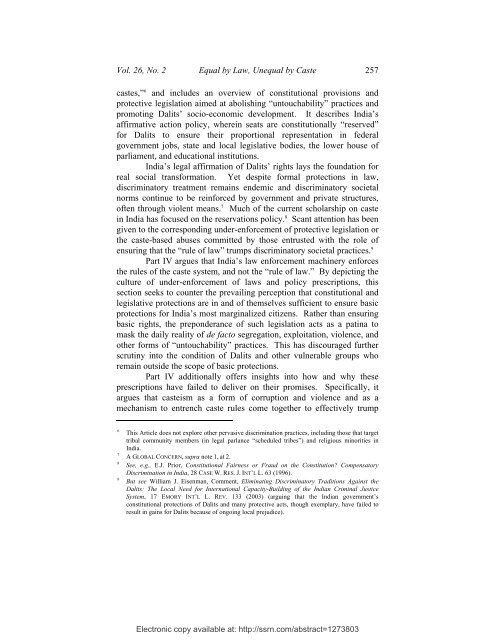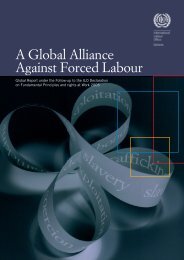256 Wisconsin <strong>International</strong> Law Journalbottom of India’s <strong>caste</strong> system. 3 To the contrary, <strong>caste</strong>-baseddiscrimination, in<strong>equal</strong>ity, and oppression comfortably survive and eventhrive in modern day India. The Article further asks whether the clarioncall of “<strong>Dalit</strong> Rights are Human Rights,” 4 increasingly heeded <strong>by</strong> theinternational community and heard around the world, 5 can now succeedwhere all else has seemingly failed. It concludes that “<strong>Dalit</strong> Rights areHuman Rights” is not a self-fulfilling prophecy but one that cangalvanize a project of social transformation so long as it does not restrictitself to the constraints of the legal and moral regime in which thisstruggle now lives.Part II of this Article situates “<strong>caste</strong>” in a global context,particularly in the context of debates around affirmative action, racialin<strong>equal</strong>ity, and racial justice in the United States. In so doing, it suggeststhat the discourse surrounding the struggle for <strong>Dalit</strong>s rights in Indiabrings the fallacy of anti-affirmative action arguments in the UnitedStates into sharp relief. Part II then presents an overview of the <strong>caste</strong>system and <strong>caste</strong>-based discrimination and in<strong>equal</strong>ity in India today,paying specific attention to the intersection of <strong>caste</strong> and gender-baseddiscrimination and the impact on <strong>Dalit</strong>s of India’s aggressive shift from astate regulated economy to a market economy.Part III focuses on Indian policies for redressing <strong>caste</strong>discrimination against <strong>Dalit</strong>s, known in legal parlance as “scheduled345An estimated additional 42 million Muslim and Christian <strong>Dalit</strong>s are also vulnerable todiscrimination. Memorandum, National Campaign on <strong>Dalit</strong> Human Rights, Background of the<strong>Dalit</strong> Situation in India, Sept. 2007 (on file with author).See generally Clifford Bob, “<strong>Dalit</strong> Rights Are Human Rights:” Caste Discrimination,<strong>International</strong> Activism, and the Construction of a New Human Rights Issue, 29 HUM. RTS. Q.167 (2007) (analyzing recent efforts <strong>by</strong> Indian <strong>Dalit</strong> and international activists to “transformcenturies-old <strong>caste</strong>-based discrimination into an international human rights issue”). See alsoNational Campaign on <strong>Dalit</strong> Human Rights, <strong>Dalit</strong> Rights are Human Rights: A Charter of <strong>Dalit</strong>Human Rights (on file with author).See, e.g. H.R. Con. Res. 139, 110th Cong. (2007) (expressing sense of Congress that UnitedStates should address the problem of untouchability in India); Resolution on the Human RightsSituation of <strong>Dalit</strong>s in India, Eur. Parl. Doc. B6-0021 (2007) (urging Indian government to tackleproblem of <strong>caste</strong>-based discrimination); U.N. Committee on the Elimination of RacialDiscrimination, Concluding Observations of the Committee on the Elimination of RacialDiscrimination [in response to the report submitted <strong>by</strong> India], U.N. Doc. CERD/C/IND/CO/19(Mar. 6, 2007). For a general overview of the position of various U.N. human rightsmechanisms on the issue of <strong>caste</strong> discrimination, see generally CENTER FOR HUMAN RIGHTS ANDGLOBAL JUSTICE & HUMAN RIGHTS WATCH, HIDDEN APARTHEID: CASTE DISCRIMINATIONAGAINST INDIA’S UNTOUCHABLES (2007), available at http://www.hrw.org/reports/2007/india0207/india0207webwcover.pdf [hereinafter HIDDEN APARTHEID].Electronic copy available at: http://ssrn.com/abstract=1273803
Vol. 26, No. 2 Equal <strong>by</strong> Law, Un<strong>equal</strong> <strong>by</strong> Caste 257<strong>caste</strong>s,” 6 and includes an overview of constitutional provisions andprotective legislation aimed at abolishing “untouchability” practices andpromoting <strong>Dalit</strong>s’ socio-economic development. It describes India’saffirmative action policy, wherein seats are constitutionally “reserved”for <strong>Dalit</strong>s to ensure their proportional representation in federalgovernment jobs, state and local legislative bodies, the lower house ofparliament, and educational institutions.India’s legal affirmation of <strong>Dalit</strong>s’ rights lays the foundation forreal social transformation. Yet despite formal protections in <strong>law</strong>,discriminatory treatment remains endemic and discriminatory societalnorms continue to be reinforced <strong>by</strong> government and private structures,often through violent means. 7 Much of the current scholarship on <strong>caste</strong>in India has focused on the reservations policy. 8 Scant attention has beengiven to the corresponding under-enforcement of protective legislation orthe <strong>caste</strong>-based abuses committed <strong>by</strong> those entrusted with the role ofensuring that the “rule of <strong>law</strong>” trumps discriminatory societal practices. 9Part IV argues that India’s <strong>law</strong> enforcement machinery enforcesthe rules of the <strong>caste</strong> system, and not the “rule of <strong>law</strong>.” By depicting theculture of under-enforcement of <strong>law</strong>s and policy prescriptions, thissection seeks to counter the prevailing perception that constitutional andlegislative protections are in and of themselves sufficient to ensure basicprotections for India’s most marginalized citizens. Rather than ensuringbasic rights, the preponderance of such legislation acts as a patina tomask the daily reality of de facto segregation, exploitation, violence, andother forms of “untouchability” practices. This has discouraged furtherscrutiny into the condition of <strong>Dalit</strong>s and other vulnerable groups whoremain outside the scope of basic protections.Part IV additionally offers insights into how and why theseprescriptions have failed to deliver on their promises. Specifically, itargues that <strong>caste</strong>ism as a form of corruption and violence and as amechanism to entrench <strong>caste</strong> rules come together to effectively trump6789This Article does not explore other pervasive discrimination practices, including those that targettribal community members (in legal parlance “scheduled tribes”) and religious minorities inIndia.A GLOBAL CONCERN, supra note 1, at 2.See, e.g., E.J. Prior, Constitutional Fairness or Fraud on the Constitution? CompensatoryDiscrimination in India, 28 CASE W. RES. J. INT’L L. 63 (1996).But see William J. Eisenman, Comment, Eliminating Discriminatory Traditions Against the<strong>Dalit</strong>s: The Local Need for <strong>International</strong> Capacity-Building of the Indian Criminal JusticeSystem, 17 EMORY INT’L L. REV. 133 (2003) (arguing that the Indian government’sconstitutional protections of <strong>Dalit</strong>s and many protective acts, though exemplary, have failed toresult in gains for <strong>Dalit</strong>s because of ongoing local prejudice).Electronic copy available at: http://ssrn.com/abstract=1273803
- Page 1: EQUAL BY LAW, UNEQUAL BY CASTE: THE
- Page 5 and 6: Vol. 26, No. 2 Equal by Law, Unequa
- Page 7 and 8: Vol. 26, No. 2 Equal by Law, Unequa
- Page 9 and 10: Vol. 26, No. 2 Equal by Law, Unequa
- Page 11 and 12: Vol. 26, No. 2 Equal by Law, Unequa
- Page 13 and 14: Vol. 26, No. 2 Equal by Law, Unequa
- Page 15 and 16: Vol. 26, No. 2 Equal by Law, Unequa
- Page 17 and 18: Vol. 26, No. 2 Equal by Law, Unequa
- Page 19 and 20: Vol. 26, No. 2 Equal by Law, Unequa
- Page 21 and 22: Vol. 26, No. 2 Equal by Law, Unequa
- Page 23 and 24: Vol. 26, No. 2 Equal by Law, Unequa
- Page 25 and 26: Vol. 26, No. 2 Equal by Law, Unequa
- Page 27 and 28: Vol. 26, No. 2 Equal by Law, Unequa
- Page 29 and 30: Vol. 26, No. 2 Equal by Law, Unequa
- Page 31 and 32: Vol. 26, No. 2 Equal by Law, Unequa
- Page 33 and 34: Vol. 26, No. 2 Equal by Law, Unequa
- Page 35 and 36: Vol. 26, No. 2 Equal by Law, Unequa
- Page 37 and 38: Vol. 26, No. 2 Equal by Law, Unequa
- Page 39 and 40: Vol. 26, No. 2 Equal by Law, Unequa
- Page 41 and 42: Vol. 26, No. 2 Equal by Law, Unequa
- Page 43 and 44: Vol. 26, No. 2 Equal by Law, Unequa
- Page 45 and 46: Vol. 26, No. 2 Equal by Law, Unequa
- Page 47 and 48: Vol. 26, No. 2 Equal by Law, Unequa
- Page 49 and 50: Vol. 26, No. 2 Equal by Law, Unequa
- Page 51 and 52: Vol. 26, No. 2 Equal by Law, Unequa
- Page 53 and 54:
Vol. 26, No. 2 Equal by Law, Unequa
- Page 55:
Vol. 26, No. 2 Equal by Law, Unequa
- Page 58 and 59:
312 Wisconsin International Law Jou
- Page 60 and 61:
314 Wisconsin International Law Jou
- Page 62 and 63:
316 Wisconsin International Law Jou
- Page 64 and 65:
318 Wisconsin International Law Jou
- Page 66 and 67:
320 Wisconsin International Law Jou
- Page 68 and 69:
322 Wisconsin International Law Jou
- Page 70 and 71:
324 Wisconsin International Law Jou
- Page 72 and 73:
326 Wisconsin International Law Jou
- Page 74 and 75:
328 Wisconsin International Law Jou
- Page 76 and 77:
330 Wisconsin International Law Jou
- Page 78 and 79:
332 Wisconsin International Law Jou
- Page 80 and 81:
334 Wisconsin International Law Jou
- Page 82 and 83:
336 Wisconsin International Law Jou
- Page 84 and 85:
338 Wisconsin International Law Jou
- Page 86 and 87:
340 Wisconsin International Law Jou
- Page 88 and 89:
342 Wisconsin International Law Jou
















